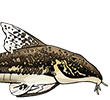In the absence of detailed information about diet, activity etc. for species, the next best approach to bio-load, imo, is to use body mass. Simply put, the bigger the fish, the more waste and ammonia it can make. So the fist issue is how big are the 6 whippies? If they are very young and fairly small, that is one thing, but if they have any size to them, I do not think the 55 will handle them if they are decent size, the tank will likely make too much ammonia for your current nitrifying bacteria to handle. So in your case imagine if you weighed all the tetras and then weighed the new whiptails, this would give you a clue. I tend to ask myself how many tetras would it take to build a mass the size of the cat. Focus on SL body mass.
This leaves you a few options. As you noted you can add cycled filters or media to the tank. But there is no way to be 100% sure this is enough. Another option is the add a viable bottled bacteria product to the tank before the new fish go in. I only suggest two brands and I am not sure if you can get them my personal favorite is DR. Tims One and Only Nitrifying bacteria and my second choice is tetras Safe Start. These are very similar as Dr. Timothy Hovanec is basically responsible for both.
I have used Dr. Tim's on a number of occasions and always keep some in my fridge for emergency use. I recently had to put 20 large adult sterbai cory into a 20 gal long. I had one small cycled 200 gph filter which I knew would not be anywhere near enough. So I did two things. First i added some plants to the tank since they use ammonia and also have bacteria on them. The next thing I did was use enough Dr. Tims to cycle about 20 gals. I also had the luxury of being able to add a single 2 ppm dose of ammonium chloride the day before I got the fish. This helps get the bacteria "revved up." I lost no fish and they were spawning in the tank almost within a week.
I would also note that I tested the tank for ammonia before allowing the fish to go in. it was .25 ppm. In my water params that meant the amount of that total ammonia which was in the toxic NH3 form was below the danger level of .05 ppm. NH3 levels under .02 ppm are considered safe for almost all forms of aquatic life. Despite that, I did a big water change before putting the fish into the tank.
Bear in mind that the ammonia can double in about 8-10 hours for the ammonia oxidizers and about 12-14 for the nitrite ones- under optimal conditions. So if my tank was able to process 1.75 ppm of ammonia over night leaving that .25 ppm, I was short about 12.5% of the bacteria needed. The amount of time required to remedy this via reproduction would be about 12.5% of 8 -10 hours or basically under two hours for both AOB and NOB.
If you want to calculate the amount of NH3 for any total ammonia reading to know how harmful it might be, you need to know the total ammonia, the pH and the temperature of the tank in fw aquariums. Then you need an ammonia calculator like this one
http://www.hamzasreef.com/Contents/Calc ... mmonia.php It one works with fw, brackish and sw. For fw enter 0 for the salinity. Also, unless your are using a test kit which states it measures Ammonia-N or as nitrogen, select NH (NH3 + NH4) for the Total Ammonia Type.
Last comment, just to be safe, do not dose ammonia into any tank which contains fish or inverts. While I could do this in the example above, you cannot do it in the 55 which contains fish.
Hope this all helps.






